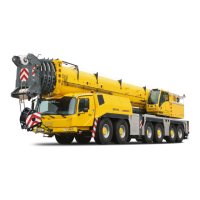Grove Published 07-06-2017, Control # 406-03 3-17
CD5520/YB5520 OPERATOR MANUAL OPERATING CONTROLS AND PROCEDURES
Traveling with the Crane
1. Enter the operator’s cab, close the door, if equipped, and
fasten the seat belt.
2. Start the engine and disengage the parking brake.
3. Select either the Forward (F) or Reverse (R) travel
position on the transmission shift lever (see
Figure 3-24).
• The crane has no axle suspension. Traveling at high
speeds, especially on rough roads, can create a
bouncing effect that can result in loss of control.
Personal injury, death and property damage could
result. Reduce speed if bouncing occurs.
4. Start out traveling from a stopped position in 1st gear.
Travel speed may be shifted from 1st to 2nd, 2nd to 3rd,
3rd to 4th when the crane is moving. See “Shifting
Gears”, below. Avoid operating at too high a speed when
moving a heavy load, as this may cause “lugging” on the
engine. Use a lower gear when moving a heavy load;
higher gear when moving a lighter load. SELECTING
THE CORRECT TRAVEL SPEED WILL PROLONG
ENGINE LIFE.
CAUTION
If travel sight is restricted, do not attempt to travel with the
crane until a signalman gives a signal that the crane is
clear of obstacles in the wheel path. Remove any
obstacles from the wheel path before moving.
To help prevent accidents, use a “Slow Moving Vehicle”
Sign and a flashing strobe light (where legal) for traveling
on highways or public roads.
The operator’s seat is equipped with a seal belt. Use this
belt at all times when operating the crane.
w0003
CAUTION
To avoid damage to the parking brake and crane, do not
apply the parking brake while traveling.
Disengage the parking brake before driving. Damage to
the crane can occur.
FIGURE 3-24
Travel Select
Lever (Typical)
Kickdown Switch
Reference Only

